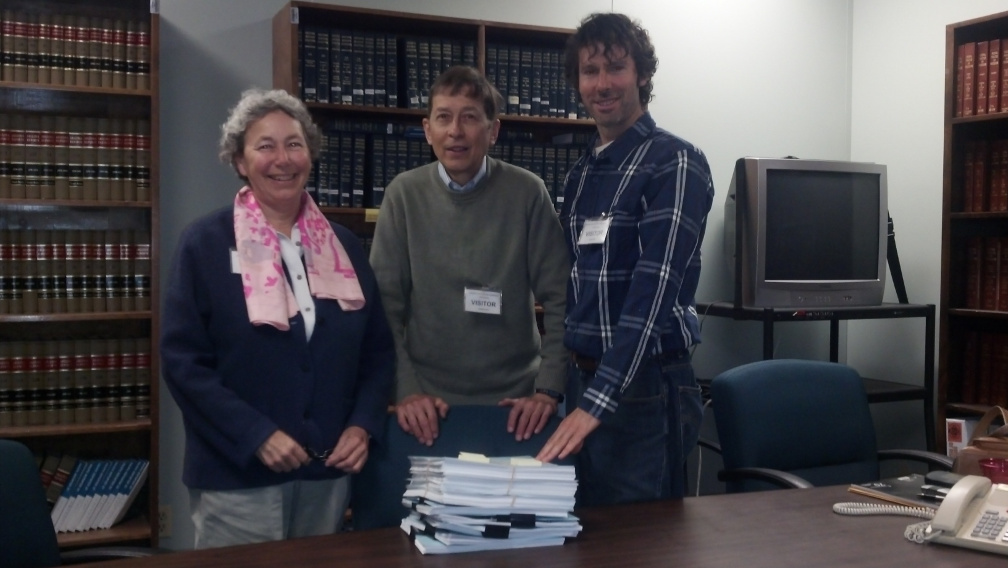<-- More Recent News
October 2015
September 2015
March 2015
February 2015
January 2015
BLM Releases its Record of Decision (ROD) on the SunZia project, January 23rd―――――――――――――――
Other January News---
December 2014
November 2014
August 2014
July 2014
April 2014
FOIA Time!

January 2014
December 2013
July 2013
From the Benson News-Sun:
County supervisors protest BLM's SunZia route
$1.2 Billion Power Line Proposal Raises Concerns at White Sands Missile Range
"Green" on green scuffle High Country News compares CWG's position with the opinion of Boulder-based Western Resource Advocates
June 2013
May 2013
April 2013
March 2013
February 2013
January 2013
Older News -->
 |

|
October 2015
- Letter from Arizona Audubon to the ACC Line Siting Committee
- Please consider and download our SunZia talking points for discussion with the Arizona Corporation Commission
September 2015
- -->Let Your Voice Be Heard
Finally, SunZia is moving to the Arizona Corporation Commission for their Certificate of Environmental Compatibility, the state permit needed to construct the project. Let your voice be heard !http://eservice.azcc.gov/Utilities/PublicComment*
You must include the docket number, L-00000YY-15-0318-00171 (yes, that whole thing).
*We've learned that web submission of comments is restricted to 1000 characters (not words!). Although better than nothing, it is preferable to submit your comments in writing (click here for details)
-
The Line Siting Committee hearing for the permit will be as follows. We'll be there!
Willcox, October 19-21, Community Center
Tucson, October 22-23, November 2-3, Tucson Convention Center
Casa Grande, November 4-5, Holiday Inn
Florence (if needed), November 16-20, Holiday Inn
Details are available here, including all comment options, evening public comment periods, tour info, and how to access SunZia's application online. Anyone can attend the hearing and provide public comment, either at an evening session or at the beginning of each hearing day (except tour days).
- The latest news from New Mexico:
"SunZia Project still a Concern,"
http://www.abqjournal.com/639686/opinion/sunzia-project-still-a-concern.html
March 2015
- From the Deming Headlight,
Land commissioner hears concerns about SunZia
(CWG's Anna Land's public statement is at the end of the article. The writer confused her with Frances Williams.) - From the Las Cruces Bulletin,
SunZia opponents trek to SLO Deming hearing
February 2015
- From CWG's Mick Meader, Financing and Building SunZia: Is It Possble?
- From Peter Else and our friends at the Friends of Aravaipa Region (FAR),
Decision by Secretary Jewell on SunZia Transmission Project― How Did We Get Here?
Recourse on the Federal Decision Being Considered ― Those wishing to support this effort or offer legal help can contact the author - Lots of quotes from CWG in the Willcox Range News:
Sunzia transmission line gets fed's OK
The harm the project would cause "is entirely unnecessary given that the project is not needed to meet any renewable energy needs in Arizona or California and would squander both financial and environmental resources if built,"
January 2015
BLM Releases its Record of Decision (ROD) on the SunZia project, January 23rd―――――――――――――――
- **Cascabel Working Group's Press Release
- Center for Biological Diversity's Press Release
- Tucson Weekly: Feds OK Controversial Power Line Project That'll Go Right in the Middle of the San Pedro River Valley; Environmentalists Are Angry -with quotes from Peter Else
- Arizona Daily Star: With federal OK, SunZia to seek states' approval
- Arizona Public Media (NPR):
Power Line Project Gets Final Federal Permit
"All of the environmental organizations here in Southern Arizona are working on this," said Cascabel Working Group's Mick Meader, "and are working on a challenge to the [Environmental Impact Statement]."
- From the Albuquerque Journal: SunZia line to get green light
- And---in our opinion, for some over-the-top political theater (a high-level publicity piece meant to make the Obama Administration look sparkling on jobs and the environment), read the press release from the Department of the Interior
Other January News---
- From the Albuquerque Journal: NM land commissioner puts the brakes on SunZia
December 2014
- CWG's comments on the Environmental Impact Statement for the burial of SunZia's proposed lines
across the Northern Extension of the White Sands Missile Range:
- Burial EIS Comments Letter 1
- Burial EIS Comments Letter 2
- Comments from Peter Else of Friends of Aravaipa Region (FAR)
- Mary Kay Papen and Steve Pearce: SunZia line through WSMR
Endangers National Security
12/7/14 in the Las Cruces Sun-News
November 2014
- BLM releases the Environmental Impact Statement for the burial of SunZia's proposed lines
across the northern part of the White Sands Missile Range
- Click
here for the EIS
(Note: these links can change; if it is broken, start at the BLM's main SunZia page here.) - Their ruling: Finding of No New Significant Impact (FONNSI)
- Click
here for the EIS
August 2014
"It must be built as a public works project if it is to be built. A private company will go bankrupt trying." -Cascabel Working Group's co-chair, Mick Meader
from the Sante Fe New Mexican article Heinrich: Deal with feds paves way for SunZia transmission line
July 2014
- SunZia unlikely to approved until early next year, if then:
"...BLM would conduct a more in-depth supplement to the final environmental impact statement (EIS) that it released for the New Mexico-to-Arizona SunZia project in June 2013. A supplement to the final EIS could take as long as two years to complete, said Donna Hummel, a BLM spokeswoman in Santa Fe, N.M.
-from eenews.net's Greenwire [subscription required]
Until the issue is resolved, a formal record of decision authorizing the project will not be issued, said Dave Goodman, planning and environmental coordinator in BLM's New Mexico State Office.
A final EA that determines the next step for the transmission project that the Obama administration says is critical to developing wind and solar power in both states likely won't be completed until early next year, Goodman said.".
- SunZia to Bury Proposed Lines - Pentagon, project developers strike deal on N.M. missile range
- Here is the letter from the DoD to Interior Secretary Jewell, explaining their requirement of 5 buried miles, in up to 3 sections.
- CWG's Report on the Cost and Time to Bury the Lines
- CWG Report: SunZia's Fatal Flaw: Arizona's Transmission System
April 2014
- From Tucson Audubon's Vermillion Flycatcher SunZia Process Undermines Our Landmark Environmental Policy Law
- Congressman says MIT report found problems with major power line project
- From the Albuquerque Journal:
Pearce, SunZia clash over MIT study
"This study was done for the benefit of SunZia and it validated the DOD's position. It's not the answer SunZia wanted, but they need to accept it."

January 2014
- Third-party Findings on SunZia Project Repeatedly Ignored from the Albuquerque Journal by Peter Else and Mick Meader
- SunZia: The Selective and Arbitrary Use of Science in an Environmental Impact Statement. From Tucson Audubon's Vermillion Flycatcher
December 2013
-
Plans for SunZia Transmission Line through AZ Based on False Premises
Op-ed in the Arizona Star by CWG co-chair Mick Meader - Letter from CWG to Secretary of Interior Sally Jewel and BLM Director Neil Kornze
- Read a letter from Representatives Ron Barber and Ann Kirkpatrick to Secretary of Interior Sally Jewel citing concerns about the SunZia FEIS. Introduces a letter from Peter Else (of Friends of Aravaipa). 2nd letter from the Representatives to Jesse Juen of the BLM.
- From the Albuquerque Journal, National security comes first over SunZia's plans
- SunZia can find better route for power line
- Read an editorial in the Wilcox Range News by Kathy Suagee and Mick Meader (CWG co-chair), San Pedro River & SunZia Power Line
- Tucson Audubon's Vermillion Flycatcher article White Sands Impediment to SunZia
- From the Albuquerque Journal, ABQ Chamber backs DOD position on SunZia power line
- CWG covered in an article by the High Country News: Renewable Energy Transmission Projects Create Tension Among Greens
-
Defense Protests White Sands Wind-Power Line on National Security Grounds
Supporting Documents:
- DoD's Technical Working Group Analysis of SunZia
- John Conger, Under Secretary of Defense (acting deputy), August 7, 2013 letter to Neil Kornze, BLM Principal Deputy Director, regarding the Technical Study, emphasizing Frank Kendall's March 19 comments (next bullet)
- Frank Kendall, Under Secretary of Defense, March 19, 2013 letter to David Hayes, Deputy Secretary of the Interior Department, stating that the current SunZia route represents an unacceptable risk to national security and urging the Department of Interior to reopen the NEPA process
- Las Cruses Sun-News:
Sen. Heinrich urges federal action on SunZia power line
It appears that the Senator's staff wrote the letter from information that SunZia provided. It also appears that they have not studied DoD's report or letters to the BLM and are completely taken in by SunZia's arguments, without a critical counter-analysis. In my opinion, they would not have written a letter like this had they had more contact with DoD and studied the project more. Sen. Heinrich also seems to be unaware of the huge environmental impacts in Arizona...
- DoD to BLM: SunZia route threatens White Sands missions
July 2013
- Coalition Protest of the FEIS and Resource Management Plan Amendments
- Read CWG's rebuttal to the BLM's (EPG's) response to our DEIS comments
- Some responses are unrelated to the comments that were made.
- Some responses misinterpret or do not fully understand the comments that were made.
- Some responses avoid the issues that were raised and employ tangential arguments to address them.
- Some of the information that EPG's responses contain is inaccurate or incomplete.
Instead of incorporating the substance of public comments into the FEIS as fully as possible to complement the DEIS, in most cases EPG uses any possible argument or statement to dismiss them. Rather than duly consider what was submitted, EPG expediently dispenses with it to comply with NEPA's administrative requirement to respond somehow. As our attached reply to EPG's responses states, "The dismissal of public commentary by the BLM (or EPG) in its responses is so sweeping and biased that it brings into question the validity of the process." - CWG's Mick Meader quoted in Energy Prospects West's article BLM Chooses SunZia Route
- Archaeology Southwest's recent actions on SunZia: Proposed Transmission Line Threatens San Pedro Valley - Update, July 2013
- Pentagon and Environmentalists Unite in Opposition to Proposed Power Line Route by Bob Brewin
-
Military, Power Line at Odds
- Response by Mick Meader to author Milan Simonich:
"Those job numbers quoted for SunZia are false."
- Response by Mick Meader to New Mexico Senator Martin Heinrich, who strongly supports SunZia and
is quoted at length:
"You seem unaware of the deeper facets and difficulties of this project."
- Response by Mick Meader to author Milan Simonich:
June 2013
- June 14th: BLM releases the SunZia project Final Environmental Impact Statement (FEIS)
- CWG's First Response to FEIS - press release
- Scrap the ill-advised SunZia project -
Albuquerque Journal editorial by Peter Else
Other proposals do not mislead the public with exaggerated renewables claims - Wilderness Society press release on the FEIS:
Challenges in siting SunZia transmission line highlight need for regional planning: .
Proposed routes would impact wildlands and wildlife habitat
There is an audio sound bite available featuring TWS's Alex Daue. Right click here to download. - Congressman Grijalva's strong press release on the FEIS
- News release from Defenders of Wildlife
- Debate rages over merits of SunZia power line, adequacy of BLM's analysis from the E&E reporter
- CWG's press release "SunZia Environmental Impact Statement Avoids Issues, Harms Arizona's Heritage " in the Tucson Citizen
- Audubon Flycatcher article by Mick Meader
May 2013
- Route not only problem with SunZia - CWG's Mick Meader's response to Tom Wray's Albuquerque Journal editorial. (pdf version)
- An article in New Mexico's El Defensor Chieftain explains the ongoing controversy between the Dept of Defense and SunZia.
- Tom Wray of SunZia published a guest opinion in the Albuquerque Journal. We noticed that Mr Wray continues to use invalidated data from a SunZia-sponsored Economic Impact study from New Mexico State University. (Read our January 2012 critique of this study, showing how the numbers he is siting are extremely misleading.)
April 2013
- CWG has submitted a Supplemental EIS Request to the BLM, and also signed on to a Coalition Supplemental EIS Request, which offers additional reasons why one is needed
- Army: SunZia line proposal a threat to national security! Note that BLM NM State Director Jesse Juen does -not- sound like a neutral party. Why does it sound as if he is actually advocating for SunZia?
March 2013
- The military has issues with SunZia: SunZia project still on hold
- Some news from last year (March 2012) to keep you reading-
Here are SunZia's comments to the US Department of Energy - "Rapid Response Transmission Team" (the group behind the Fast Tracking process). Also available are comments submitted by a coalition of environmental groups
February 2013
-
SunZia: An Unnecessary High-Risk Project?
A response to the report "Evaluating the SunZia Transmission Line Proposal A Guide for Stakeholders and Decision Makers "
Some highlights:
- The SouthWestern Power Group (SWPG) initially proposed SunZia to expand the markets for its permitted 1,000-megawatt power plant in S.E. Arizona, hoping to make it more economic, and SWPG yet intends to use SunZia for this purpose. The later expansion of SunZia did not diminish this need.
- While New Mexico wind generation might help SunZia succeed, it alone cannot support a project of this scope. For the project to have any chance of success, natural gas generation must play a central role in it. Even combined, both forms of generation may be unable to support the project. This uncertainty makes the projects economic outcome questionable.
- When SunZia was conceived, it was thought that New Mexicos renewable energy might help other states in the Southwest meet their renewable energy goals. However all states targeted for New Mexicos renewable energy projects are now expected to meet and exceed their Renewable Portfolio Standard (RPS) requirements with their own resources, and SunZia is not needed to meet them. This is especially true for California. This makes long-distance transmission of renewables unnecessary, meaning that New Mexicos solar and wind energy is far more likely to stay in New Mexico.
- This analysis indicates that the methodology and economic analysis of the draft Environmental Impact Statement for SunZia is deeply flawed. The justification used in the draft EIS for SunZia is so incomplete that legal challenges may delay or stop the project. This possibility raises further questions about projects viability.
CWG's Mick Meader: "This is a highly tenuous and economically risky project, ...As proposed, it cannot be financed. The size of the project far exceeds the power needs in the region, and building a project merely to satisfy energy speculators does not make sense."
Additional Conclusions of the Report:
- Natural gas generation could easily come to dominate the projects use, as SunZia would parallel the El Paso Natural Gas pipeline in southwestern New Mexico and southeastern Arizona for nearly 200 miles. In the last 11 years 1,045 megawatts of generation have been built along this pipeline and another 1,000 megawatts permitted. Given the enormous future projections for natural gas generation in the Southwest and the ease with which this existing generation can be expanded, the majority of the power eventually carried by SunZia could easily be natural gas generated.
- The completion of the 570-megawatt Luna Energy Facility in Deming, New Mexico in 2006 eliminated any physical congestion on the transmission system in southwestern New Mexico, and SunZia is not now needed to increase power delivery in this region.
- Building SunZia cannot be justified merely because New Mexico has abundant, high-quality renewable resources. All other western states, including Arizona, California, and Nevada, that might use New Mexicos renewable energy have been developing their own capacity too quickly for New Mexico to gain control of the renewable transmission market and ensure sale of the states power.
- Some local fun on a familiar topic:
Highly Recommended --> just for fun
January 2013
- CWG's Mick Meader has met in person with John Shepard, senior advisor for the Sonoran Institute, who is the principal
author of their report released in November [see Dec 2012 news section].
This report is misleading and damages efforts to show how this project may actually be used. It reinforces the BLM's and SunZia's mischaracterizations of the project as carrying mostly renewable energy rather than shows where they are wrong. The Sonoran Institute report was a huge undertaking requiring more than two month's of effort. It was backed by the full resources of the Sonoran Institute and given wide publicity with policy makers and the media.
Older News -->

